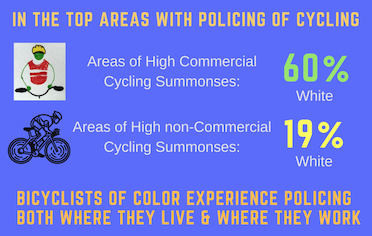Immigrant cyclists in NYC are disproportionately policed in the neighborhoods where they work and live, according to a recently-released analysis of NYPD cycling infraction data by the Biking Public Project.
From 2007 to 2015, 92 percent of commercial cycling tickets were issued in just four Manhattan precincts, covering the Upper East Side, Upper West Side, and parts of Midtown -- areas whose populations are 75 percent white. Meanwhile, non-commercial infractions were most heavily concentrated in precincts with high levels of poverty and majority-minority populations.
The severely disproportionate policing of commercial cyclists by those four Manhattan precincts -- the 17th (Midtown East), 18th (Midtown North), 19th (Upper East Side), and 20th (Upper East Side) holds true when controlling for the large number of restaurants in those areas.
In Midtown East, for example, 291 commercial cycling summonses were issued annually for every 100 restaurants. In comparison, the 88th Precinct in Fort Greene and Clinton Hill issued just .37 tickets per year per 100 restaurants.
The top eight precincts for commercial cycling infractions per 100 restaurants are all in Manhattan. "The commercial cycling infractions are all happening in affluent, white neighborhoods," Biking Public's Do Lee told Streetsblog. "Most [commercial cyclists] tend to be Asian and Latino immigrant workers."
At the same time, all but two of the top 10 police precincts for non-commercial cycling summonses are in majority-minority neighborhoods. You can toggle between the commercial and non-commercial bike enforcement datasets on this map:
"Given that most working cyclists in NYC are food delivery workers who tend to be Latino and Asian immigrants," concludes Lee in a recent summary of the research, "this map means that in NYC, people of color who bike have been policed both where they live and where they work."
Public conversations about cycling in the neighborhoods with heavy commercial bike enforcement tend to single out delivery cyclists. On the Upper East Side, for example, residents often complain about delivery cyclists in public forums about cycling and bike infrastructure. In response, Council Member Ben Kallos and the 19th Precinct have held "bike safety workshops" and promoted ticketing blitzes implicitly targeted at delivery workers.
The Biking Public Project took interest in the NYPD data after Chinese delivery workers indicated in a focus group that interactions with police were one of their primary concerns. Workers often have to choose between breaking the law and their livelihood, which depends on fast service and good tips.
Making matters more difficult, many delivery workers speak limited English, so they often don't know what they're being charged with until they get to court.
Lee notes that the number of criminal court summonses for commercial and non-commercial cycling infractions has dropped in recent years. But the data is incomplete: NYPD has not made data for non-criminal traffic summonses available to the public. The traffic violation data that is available does not differentiate between motorists and cyclists.
Lee warns that the media attention and public complaints about delivery cyclists, coupled with the reflective vests they are required by law to wear, continues to put them in an especially vulnerable position.
"This question of policing immigrant food delivery cyclists takes on particular meaning with Trump’s promise to accelerate the deportation of undocumented residents," Lee writes. "While the level of criminal summonses for commercial cycling has dropped, the laws and tools remain in place and can be revived at any given time."







